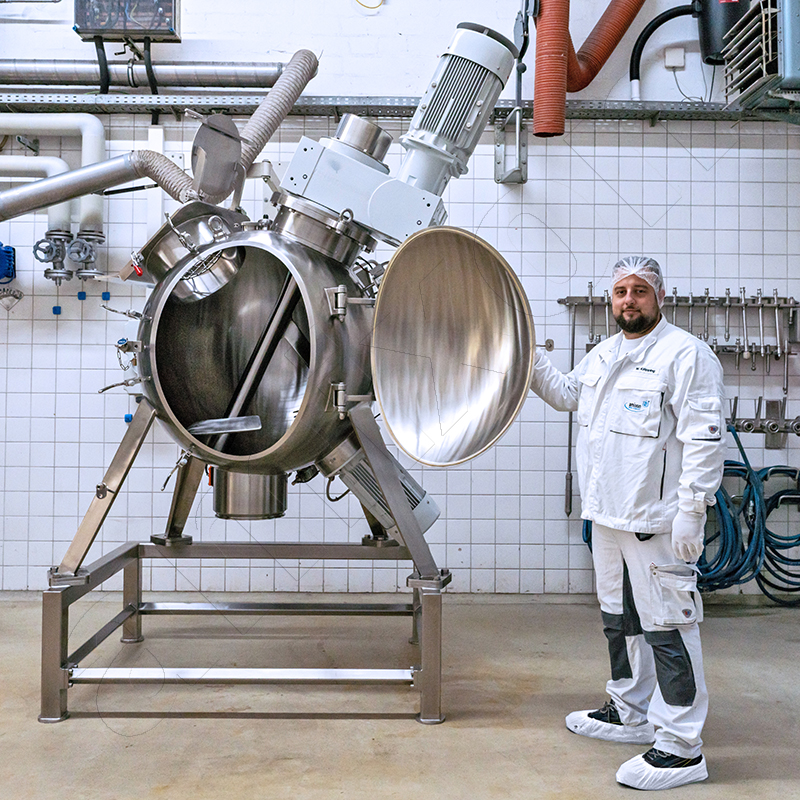
Ball mixer
Ball mixers homogenize dry, moist, or wet powders. They can also incorporate liquids. They operate in batches. The spherical mixing chamber contains a rotating mixing tool that moves the product around in three dimensions. The best mixing effect is achieved when the axis of rotation is inclined. This results in very uniform flows and short mixing times. Ball mixers produce particularly good mixing results.
amixon® is a manufacturer of ball mixers. The devices can be tested with customer-specific mixing material in the amixon® technical center. Upon request, amixon® performs an AI-supported evaluation. It combines 40 years of documented amixon® expertise with the customer's specific process requirements. The result is a well-founded recommendation for the most suitable mixing system from the amixon® range.
Ball mixers can also function as synthesis reactors or vacuum mixing dryers. For this purpose, the ball is designed with a double wall and a heat transfer medium flows through it. This allows heat to be added or removed.
The main mixing tool rotates across the entire product cross-section. Optionally, choppers can be used. They run fast, generate shear and impact effects, and break up agglomerates. This is helpful when powder is moistened, wetted, or coated. The power consumption increases in proportion to approximately 3.5 times the power of the rotational frequency.
Manufacturers offer different designs. The shaft can engage with the sphere at an angle at the top or bottom. Some designs combine the main mixing tool and chopper in different positions. It is important that all tools remain dimensionally stable and always maintain the same distance from the sphere wall – even with heavy, adhesive products.
Filling and emptying
Filling takes place from above via one or more filling nozzles. The vent is also located at the top. The emptying fitting is located at the bottom and should be shaped like a ball cutout. This is the only way to ensure dead space-free emptying.
Cleaning and inspection
Some ball mixers consist of two hinged hemispheres. Others have dead space-free inspection doors. Rotating tank washing nozzles can be used for wet cleaning. Some designs allow the cleaning nozzles to remain in the mixing chamber.
Cleaning the mixing tool is more demanding than cleaning the ball. The tool must be simple, hygienic, and easily accessible. It must be able to gently disperse powders with a wide variety of properties.
Customers can test cleaning processes and residual emptying directly on test equipment at the amixon® technical center. Depending on the industry, dry cleaning, wet cleaning, or automatic wet cleaning are used. Often, two or more cleaning regimes are combined.
Cooling after wet cleaning
After hot water wet cleaning, the mixer must cool down before the next mixing process can start. A hollow sphere releases heat primarily through radiation and convection. Cooling is slow as the temperature difference decreases continuously. Opening the mixing chamber accelerates cooling, but can release steam into the environment. In this case, targeted exhaust air guidance is recommended.
Liquid addition
Liquid lances are positioned in front of the chopper to ensure homogeneous wetting of powders. The high shearing power of the knives quickly produces a lump-free product. Influencing factors are the surface tension of the liquid, its viscosity, the porosity of the powder, and the interface interactions.
Why a sphere?
A sphere has the smallest surface area of all rotationally symmetrical containers of the same volume. This makes cleaning easier. However, a cone-shaped container is better at discharging. Both aspects have their advantages depending on the product. The decisive factors are the desired process reliability and the required residual emptying.
Terminology
A more accurate term would be “hollow sphere mixer with dynamically moving mixing tools.” However, the term “sphere mixer” is used across industries. In the sanitary sector, for example, it refers to a fitting in which a perforated sphere mixes the water supply.
